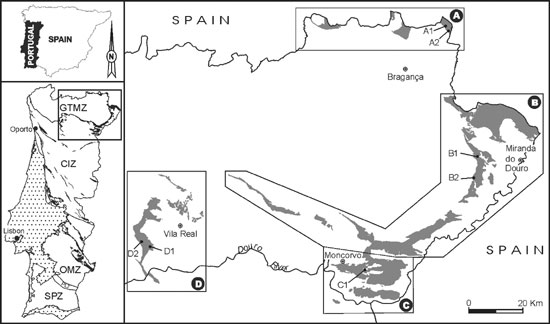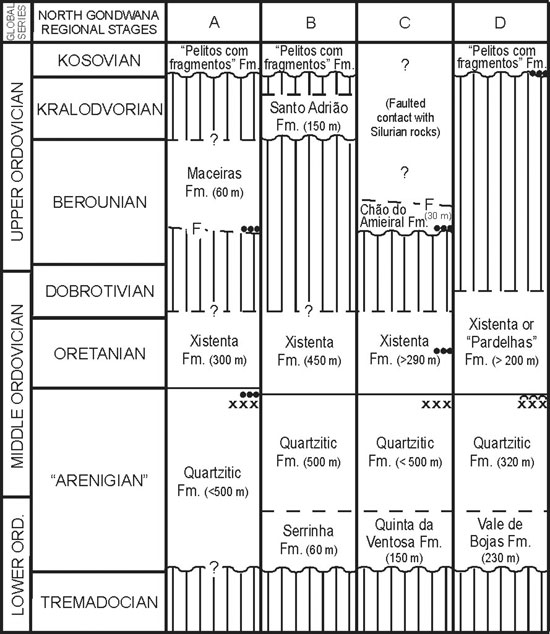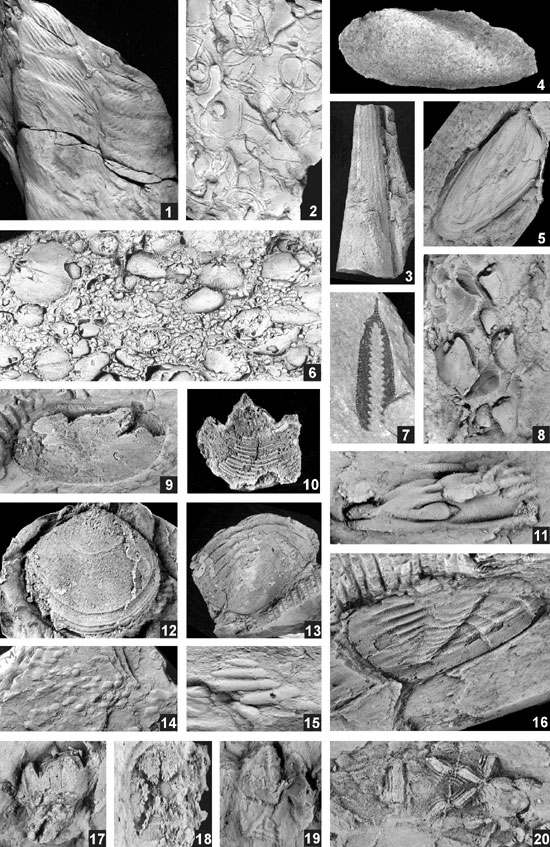
Reappraisal of the Ordovician stratigraphy and paleontology of Trás-os-Montes (Central–Iberian Zone, NE Portugal)
Artur A. Sá1, Carlos Meireles2, Carlos Coke1 and J. C. Gutiérrez–Marco3
1 Departamento de Geologia, Universidade de Trás–os–Montes e Alto Douro, Quinta de Prados, Ap. 1013, 5001–911 Vila Real, Portugal. E–mail: asa@utad.pt
2 Instituto Geológico e Mineiro, Departamento de Geologia, Ap. 1089, 4466–956 S. Mamede de Infesta, Portugal.
3 Instituto de Geología Económica (CSIC–UCM), Facultad de Ciencias Geológicas, 28040 Madrid, Spain.
Key words: Biostratigraphy. Correlation. Ordovician. Central-Iberian Zone. Portugal.
Introduction
Ordovician rocks crop out extensively (ca. 760 Km2) in the northern part of the Portuguese Central–Iberian Zone, in an area encircling the parautochthonous and allochthonous terranes of the Galicia – Trás–os–Montes Zone (Figure 1). In contrast with other Ordovician outcrops in Portugal occurring in areas further south (e.g., Valongo, Buçaco, Mação), the stratigraphy and paleontology of Ordovician sequences in the Trás–os–Montes region is very poorly known, as shown by the international syntheses of Hammann et al. (1982: stratigraphic columns 37 and 38) and Romano (1982: columns A1, A3 and A4), both with previous references. More recent contributions improve the knowledge of particular areas (Rebelo and Romano, 1986; Gutiérrez–Marco et al., 1995; Coke, 2000; Meireles, 2000) and fossils (Rebelo and Romano, 1986; Coke and Gutiérrez–Marco, 2001) but despite this, a general view for the entire area remains in an incipient stage.
This paper represents a progress report with new Ordovician data from the region of Trás–os–Montes, mainly acquired during updated geological mapping as well as a part of the Ph.D. research of the first and second authors.
Ordovician stratigraphy
Ordovician outcrops from the area under study have been subdivided in sectors according to geographical and stratigraphical characteristics, as shown in Figure 1 (A to D). The lithostratigraphical scheme for those sectors is represented in Figure 2.
In brief, the Ordovician rocks lie unconformably on the Cambrian Desejosa Formation (Douro Group), varying this contact from an angular unconformity to a paraconformity (Coke, 2000; Coke et al., 2001, and previous references). The Ordovician sequence starts with conglomerates and volcano–sedimentary rocks, probably of lower Arenigian age, transitionally followed by the ubiquitous Armorican Quartzite facies. Important iron deposits occur towards the top of the last unit, mostly in the form of stratiform diagenetic concentrations, and occasionally as oolitic ironstone (Figure 2). Overlying the quartzites is a monotonous pelitic unit (Xistenta Formation) that, according to many authors, supposedly attests continuous sedimentation from the Middle Ordovician to the Silurian (Romano, 1982, with references). However, our studies demonstrated that this unit is virtually restricted to the Oretanian; furthermore, there are pronounced gaps between the top of the Xistenta Formation and the basal Silurian rocks, as well as sporadic occurrences of Berounian, Kralodvorian and Kosovian sediments (see Figure 1 for localities).
The lowest Upper Ordovician units are represented by marls (Chão do Amieiral Formation) or by a sandstone sequence (Maceiras Formation), underlined in both cases by an oolitic ironstone horizon that is correlatable with the Favaçal bed of Buçaco and Mação (being equivalent to the basal Vinician ironstone of Mediterranean areas). In a different area, Kralodvorian limestones (Santo Adrião Formation) lie unconformably over the Xistenta Formation. Finally, Kosovian (= Hirnantian) glaciomarine diamictites seemed to have been deposited over the entire area. The "tilloid Formation" of some previous authors is not equivalent to the "Pelitos com fragmentos" Formation, because its outcrop type corresponds to a Silurian intraformational conglomerate instead of true glaciomarine diamictites.
The Figure 2 also has shown the revised thickness for most of the Ordovician formations were commonly exaggerated in some papers owing to the monothonous character of some formations

Figure 1. Geological sketch map of Ordovician outcrops in Portugal, shown in black on the left (GTMZ, Galicia–Trás–os–Montes Zone; CIZ, Central–Iberian Zone; OMZ, Ossa–Morena Zone; PLT, Pulo do Lobo Terrane; SPZ, South Portuguese Zone; Post–Paleozoic cover dotted). The detailed map to the right, corresponds to the region of Trás–os–Montes. The extent of the Ordovician outcrops is shown in grey. The main sectors are: A, Montesinho; B, Periphery of Morais Massif; C, Moncorvo–Poiares; D, Marão–Alvão. Ordovician outcrops essentially correspond to Lower and Middle Ordovician rocks. Special sections with younger rocks are labelled as follow: Berounian (A1, C1), Kralodvorian (B1) and Kosovian (A2, B2 and D2). D1 is the only locality with Dobrotivian fossils. Geological maps adapted from Carta Geológica de Portugal, 1:500.000 and 1:200.000 scales.
Paleontological notes
The Quartzitic Formation (local equivalent to the Armorican Quartzite) has been traditionally considered as the most fossiliferous unit of the Transmontan Ordovician. Starting with Delgado (1885, 1887), the abundance and diversity of ichnofossils is well known over the entire area. We have recognized the following ichnogenera: Cruziana, Daedalus, Skolithos, Palaeophycus, Monomorphichnus, Arthrophycus, Didymaulichnus and Arthraria, among others (Figure 3, 1–3). The record of shelly fauna includes examples like the giant obolid brachiopods and bivalves in the areas of Marão and Montesinho (Medeiros, 1950; Coke and Gutiérrez–Marco, 2001) (Figure 3, 4–5). The last paper reviewed alleged Precambrian–Cambrian linguloids (Lingulella major) that turned out to correspond to Arenigian forms. Linguloids shell beds are rarely recorded near the top of Quartzitic Formation in some sections (Figure 2–D). A supposed presence of "Llandeilian" trilobite Neseuretus tristani near the top of the Armorican quartzite has been reassigned as Rusophycus gr. carleyi (Gutiérrez–Marco et al., 1995). Biostratigraphical data coming from the base of the overlying unit also confirms that the alleged diacronism of the Armorican Quartzite in North Portugal does not exist (Figure 2).

Figure 2. Stratigraphic correlation of the Ordovician sequence in the Trás–os–Montes region with reference to the Global Series and to the north–Gondwanan regional stages. Thicknesses for "Pelitos com fragmentos" Formation is 30 meters in columns A and D and less than 100 meters in column B. Wavy lines, unconformity; vertical ruling, stratigraphical gaps; F, fault contact; black dots, oolitic ironstones; XXX, diagenetic ironstones; horizontal semicircles, linguloid shell bed.

Figure 3. Ordovician fossils from Trás–os–Montes. 1–5, Quartzitic Formation (Arenigian); 6–16, Xistenta Formation (Oretanian, except 6, Dobrotivian); 17–20, Chão do Amieiral Formation (middle Berounian). 1, Cruziana rugosa d’Orbigny (x 0,4); 2–3, Daedalus halli (Rouault) in transverse section (x 0,3) and lateral view (x 0,4), respectively; 4, Modiolopsis cf. aragonensis Babin (x 1,9); 5, Lingulobolus sp. (x 0,5), latex cast of ventral valve; 6, bedding assemblage with internal moulds of brachiopods (Eorhipidomella musculosa Mélou), trilobites (Morgatia hupei (Nion and Henry)), Ostracods (Reuentalina sp.) and bivalves (Praenucula sp. and Cardiolaria sp.) (x 1,1); 7, Didymograptus cf. artus Elles and Wood (x 2,4); 8, Redonia deshayesi Rouault (x 0,8); several internal moulds of valves; 9, Ribeiria pholadiformis Sharpe (x 1,4); 10, Tolmachovia sp. (x 2), composite mould of left side; 11, Salterocoryphe sp. (x 2,7), latex cast of cranidium; 12, Babinka prima Barrande (x 1,8), latex cast of external mould; 13, Pradoella cf. pradoi Hammann (x 0,9), pygidium; 14–15, Tomaculum problematicum Groom (x 1 and x 1,9, respectively); 16, Nerudaspis? sp. (x 1,6), pygidium; 17, Mespilocystites sp. (x 2,3), latex cast of theca; 18, Hemicosmitida indet. (x 1,6), internal mould of plate; 19, Caryocrinites sp. (x 2,3), latex cast of plate; 20, Heliocrinites sp. (x 2,4), latex cast of thecal plates.
The Xistenta Formation displays a large record of uppermost Arenigian to Oretanian taxa, with a single locality of confirmed Dobrotivian age (Figure 1–D1). They consist mainly of trilobites, brachiopods, graptolites, molluscs, echinoderms, ostracods, cnidarians and ichnofossils (Figure 3, 6–16). Early records were recently enlarged from the Moncorvo Synclinorium (Gutiérrez–Marco et al., 1995) but new discoveries by the first author are now extend all over the area.
Upper Ordovician units are poorly fossiliferous excepting the Chão do Amieiral Formation, where diverse record of echinoderms, brachiopods, molluscs and briozoans (Figure 3, 17–20) of middle Berounian age are being studied.
On the other hand, the Santo Adrião limestones provide some echinoderms remains but its age and stratigraphical relationships have been mainly established according lithostratigraphic correlation. The same have been applied to the uppermost Ordovician units, which are easely correlatable with glaciomarine diamictites of Kosovian (= Hirnantian) age characteristic of North Gondwanan areas.
Acknowledgements
We sincerely thank Miguel Angel San José and Guillermo Aceñolaza for their engaging reviews and suggestions. The first author gratefully acknowledges financial support from the European Regional Development Funds and the Portuguese Government (ANCCT–Ciência Viva).
References
Coke, C. 2000. Evolução Geodinâmica do ramo sul da Serra do Marão: um caso de deformação progressiva em orógenos transpressivos. Unpublished PhD Thesis, Universidade de Trás–os–Montes e Alto Douro: 330.
Coke, C. and Gutiérrez–Marco, J.C. 2001. Braquiópodos Linguliformea del Ordovícico Inferior de la Serra do Marão (Zona Centroibérica, N de Portugal). Boletín Geológico y Minero, Madrid, 112 (1): 33–50.
Coke, C., Pires, C.A.C., Sá, A.A. and Ribeiro, A. 2001. O Vulcanismo na transição Câmbrico/Ordovícico da Zona Centro–Ibérica na Região de Trás–os–Montes (NE Portugal) como elemento de referência estratigráfica. Cadernos Laboratório Xeolóxico de Laxe, Coruña, 26: 121–136.
Delgado, J.F.N. 1885. Estudo sobre os bilobites e outros fosseis das quartzites da base do Systema Silurico de Portugal. Typographia da Academia Real das Sciencias, Lisboa: 111
Delgado, J.F.N. 1887. Terrains Paléozoiques du Portugal. Étude sur les Bilobites et autres fossiles des quartzites de la base du Système Silurique du Portugal. Supplément. Typographia da Academia Real das Sciencias, Lisboa: 76.
Gutiérrez–Marco, J.C., Rebelo, A., Rábano, I. and Piçarra, J.M. 1995. Novas observações bioestratigráficas na Formação Xistenta (Ordovícico Médio) do Sinclinal de Moncorvo (Trás–os–Montes, Nordeste de Portugal). Museu e Laboratório de Mineralogia e Geologia da Faculdade de Ciências da Universidade do Porto, Porto, 4: 91–96.
Hammann, W., Robardet, M. and Romano, M. 1982. The Ordovician System in Southwestern Europe (France, Spain and Portugal). Correlation Charts and Explanatory Notes. International Union of Geological Sciences, Ottawa, Publication 11: 1–47.
Medeiros, A.C. 1950. Geologia do Jazigo de Ferro de Guadramil. Estudos Notas e Trabalhos do Serviço de Fomento Mineiro, Porto, 6 (1–4): 82–106.
Meireles, C. 2000. Carta Geológica de Portugal na Escala 1/50 000 e notícia explicativa da Folha 4–C (Deilão), 2ª Ed. Instituto Geológico e Mineiro, Lisboa: 28.
Rebelo, J.A. and Romano, M. 1986. A contribution to the Lithostratigraphy and Palaeontology of the Lower Palaeozoic rocks of the Moncorvo region, Northeast Portugal. Comunicações dos Serviços Geológicos de Portugal, Lisboa, 72 (1–2): 45–57.
Romano, M. 1982. The Ordovician biostratigraphy of Portugal – A review with new data and re–appraisal. Geological Journal, 17: 89–110.
Received: February 15, 2003
Accepted: June 15, 2003